Before getting into Bluesky statistics, we need to know the history of the platform.
When Bluesky launched with Jack Dorsey’s backing, most experts wrote it off as a tiny Twitter clone with a fancy name.
It was built as a decentralized network that gave people control, privacy, and freedom. We are talking about the stuff big platforms keep promising but rarely deliver.
Now it’s 2025, and that “tiny experiment” has turned into a full-on movement.
Bluesky runs on the AT Protocol, keeps things open-source, and still feels smooth and familiar to use.
That mix pulls in creators, journalists, and anyone who’s done being pushed around by algorithms.
If you want to understand where digital influence is moving, you need to look at Bluesky’s numbers, who’s joining, who’s engaging, and how fast it’s growing.
The ones who get in early are already building communities, while others are still figuring out what Bluesky even is.
Today, we will get into the data behind that rise: user growth, engagement stats, and how Bluesky is shaping the next wave of social media.
Key Bluesky Statistics
Here’s a quick overview of the most essential Bluesky metrics and insights that define its rise in 2025-
Registered Users & Growth Metrics
Let’s have a look at the number of registered users and the growth metrics of this platform.
How many registered users does Bluesky have?
After opening to the public, Bluesky has grown quite rapidly.
Total registered users to date (global)
As of January 2025, the platform surpassed 30 million registered users.
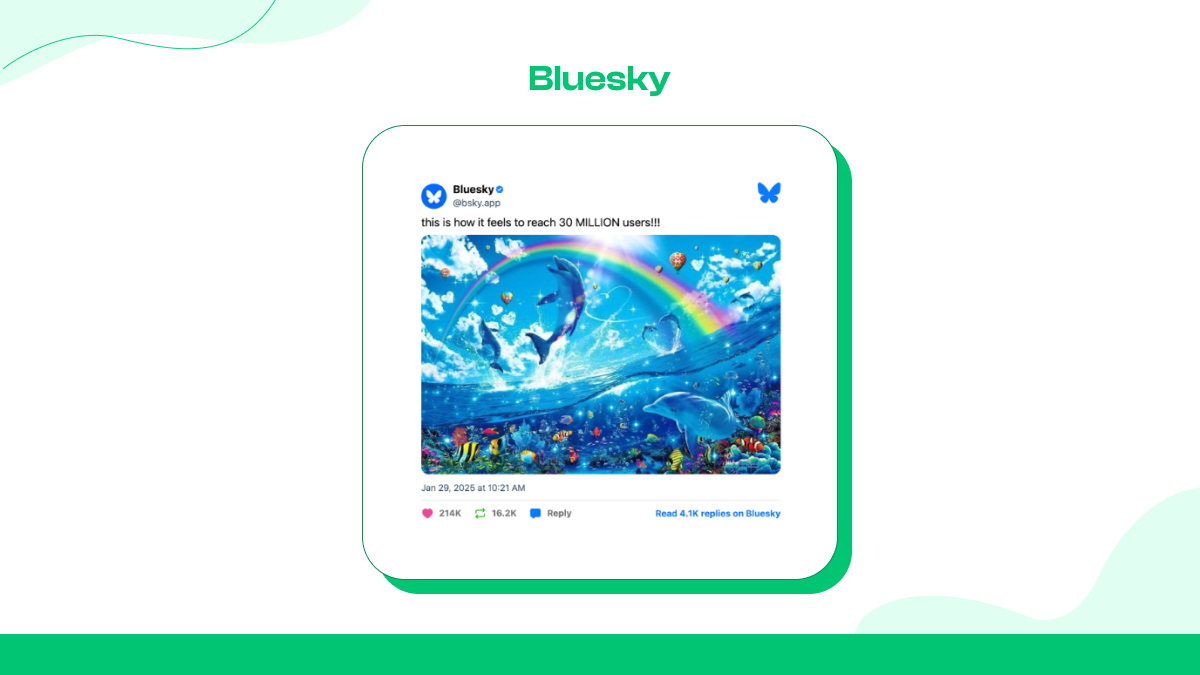
By mid-2025, various sources estimate the total at around 38 million.
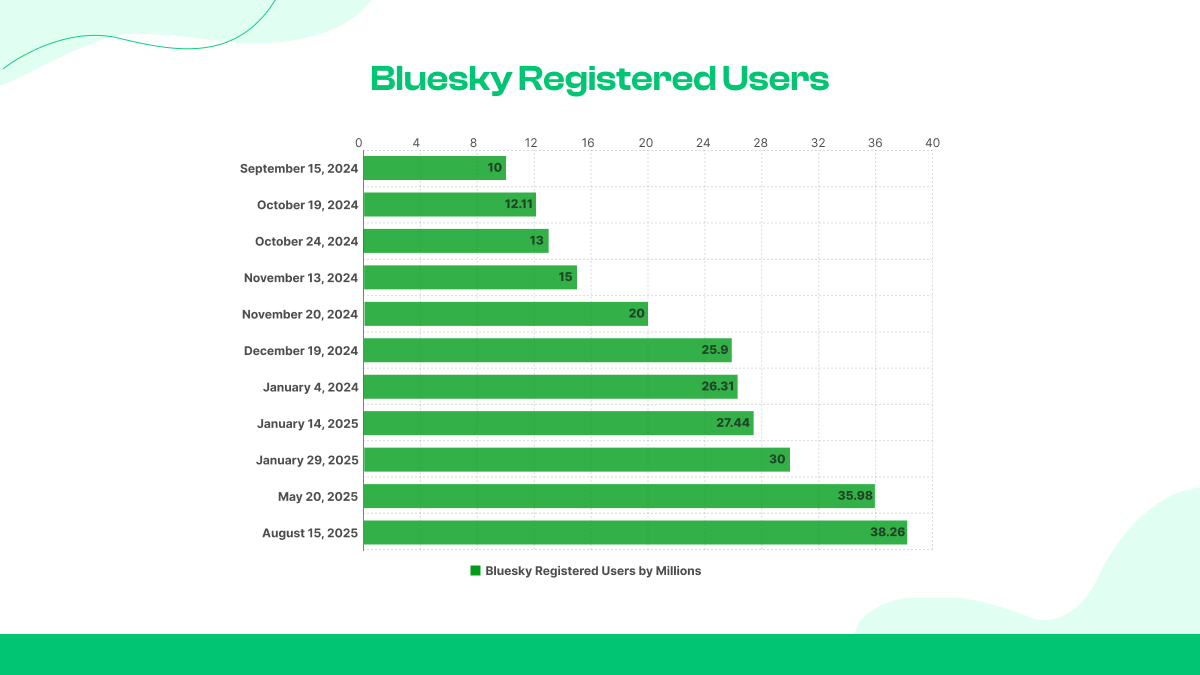
Despite being considerably lower than regular social media platforms, such figures indicate that Bluesky is turning into a significant player itself.
Growth timeline: key milestones
Here are some of the key milestones in Bluesky’s growth journey:
These milestones show how quickly the platform grew after moving from invitation-only to fully open, and how massive changes in X prompted a lot of sign-ups.
Daily/Hourly new user sign-ups
As per the estimation of a report, Bluesky was gaining approximately 0.5 users per second, or around 40,000 new registrations per day as of early 2025. [Source: productlondondesign]
Meanwhile, predictions suggest even higher potential. One source estimates that Bluesky may soon gain a user per second if the trend continues.
User growth by region & country
Since opening to the public in February 2024, Bluesky has gained users across a lot of countries very quickly.
Top countries by registered users
Key markets of the platform include the United States (largest share) and Brazil (major surge during a regional restriction of X). It also has a growing user base in Japan and other regions.
For example, one source estimated that in early 2025, the US had around 42% of registered users in the US/UK sample.
Growth rate by region
Brazil: A notable surge in Bluesky users occurred in Brazil when X was briefly banned in 2024. This surge drove a large number of Brazilians to Bluesky within a short time.
United States: User base in the US saw a steady growth, with the country boasting the largest share of Bluesky’s registered users. English-speaking users in the country actively engage on the platform.
Japan and other Asia-Pacific markets: Smaller in numbers currently, but showing potential for faster growth.
Share of registered users by region
Based on available data, as of early 2025-
Platform download & install statistics
Let’s have a look at download and install statistics.
Total app downloads (iOS + Android)
One source estimates that Bluesky app has been downloaded around 25.5 million times by mid-2025. [Source: Backlinko]
Monthly download numbers- trends over time
The number of Bluesky app downloads surged in late 2024 and early 2025, particularly when users sought alternatives to X and during regional disruptions.
For instance, Bluesky made the “top downloads” section frequently in app stores for Brazil during that period. [Source: embryo]
Data shows a major increase in monthly installs, around 7.35 million downloads in a month, when the platform saw a surge in users.
Ratio of downloads to registered users
Bluesky has around 38 million registered users, while the number of app installs is a bit over 25 million.
It suggests that many users register on the platform through other channels, such as web sign-ups, multi-device, account migrations, and some downloads lead to multiple user accounts.
In general, a rough estimate might put the ratio of downloads and registered users at around 0.67, which means two downloads for every three registered users. However, this number varies widely by region and device.
Activity & Engagement Metrics
Being a platform with vast potential, Bluesky may soon experience a bigger surge in several metrics.
Daily Active Users (DAU) & Monthly Active Users (MAU)
The number of DAUs and MAUs will help you understand the growing influence of the platform.
Estimated DAU globally & by major region
MAU figures & the DAU/MAU ratio
One dataset from November 2024 reported around 6.4 million monthly active users (MAU).
With about 4.1 million DAUs and 35-38 million registered users, the implied DAU/MAU or DAU/registered ratio is roughly 10-15%.
It indicates that while registration numbers are high, a smaller subset of users logs in daily.
Trend: Is engagement increasing or decreasing over time?
The trend shows a rapid surge during the early days, from late 2023 into 2024, but mixed signs afterwards.
For example, around the week of Thanksgiving in 2024, Bluesky’s DAUs in the USA reportedly rose 45% from previous levels. [Source: The Wrap]
However, a June 2025 report described engagement metrics, such as daily posters and likers, declining from their peak in early 2025.
Post Volumes & Content Creation
The number of posts made on Bluesky is rather high, considering the user count.
Total number of posts made on Bluesky
As of 2025, there are about 1.86 billion posts on Bluesky, according to an aggregate tracker.
Another source reported over 720 million posts at an earlier stage of the platform.
Average posts per user
With around 38 million registered users and over 1.86 billion posts, the rough average is around 49 posts per registered user. However, this number is skewed, as many users are inactive, and a smaller active cohort actually does the bulk of posting.
Posts per day/week/month
Recent trend suggests that while total post volume is high, the rate of new posts and new posting users isn’t increasing as much as the surge in new user registrations. It is around 16 million if we are counting the total number.
User Behaviour: Sessions, Bounce Rate & Retention
Let’s see how much time the average user spends on the platform.
Average session duration (per visit)
As per estimations based on a sample dataset, the average visit duration is around 6 minutes 36 seconds for the website domain.
Average pages/screens per session
Estimates say on average, 1.51 pages are viewed during a single session on Bluesky.
Bounce rate & returning-user rate
The website reported a bounce rate of approximately 43.6% in that dataset.
Engagement: Likes, Comments, Reposts
While the number of users is lower, the engagement rate on Bluesky is comparatively higher than on regular social media platforms. Let’s have a look at the rate of engagement from Bluesky users on the platform.
Average likes per post, average comments per post
Bluesky doesn’t publicly disclose detailed averages of likes or comments per post. However, a study found that for science-related posts, nearly half received at least 10 likes and about one-third were reposted 10 or more times.
Repost/share rate (how often users repost)
The same study shows that reposting or sharing activity is significantly higher in niche communities, like research or science-based communities, on Bluesky.
The rate is actually higher compared to is significantly higher than comparable posts on larger platforms.
Top accounts: follower counts, highest engagement rate
The most-followed individual account on Bluesky is politician Alexandria Ocasio‑Cortez, who represents the Democrats in Congress. She has over 2.17 million followers as of mid-2025.
However, since Bluesky is smaller, even accounts with tens of thousands of followers can get high comparative engagement rates in relation to traditional platforms.
Demographics & Audience Profile
Now let’s have a look at the demographics and profile of Bluesky's audience.
Age & Gender Distribution
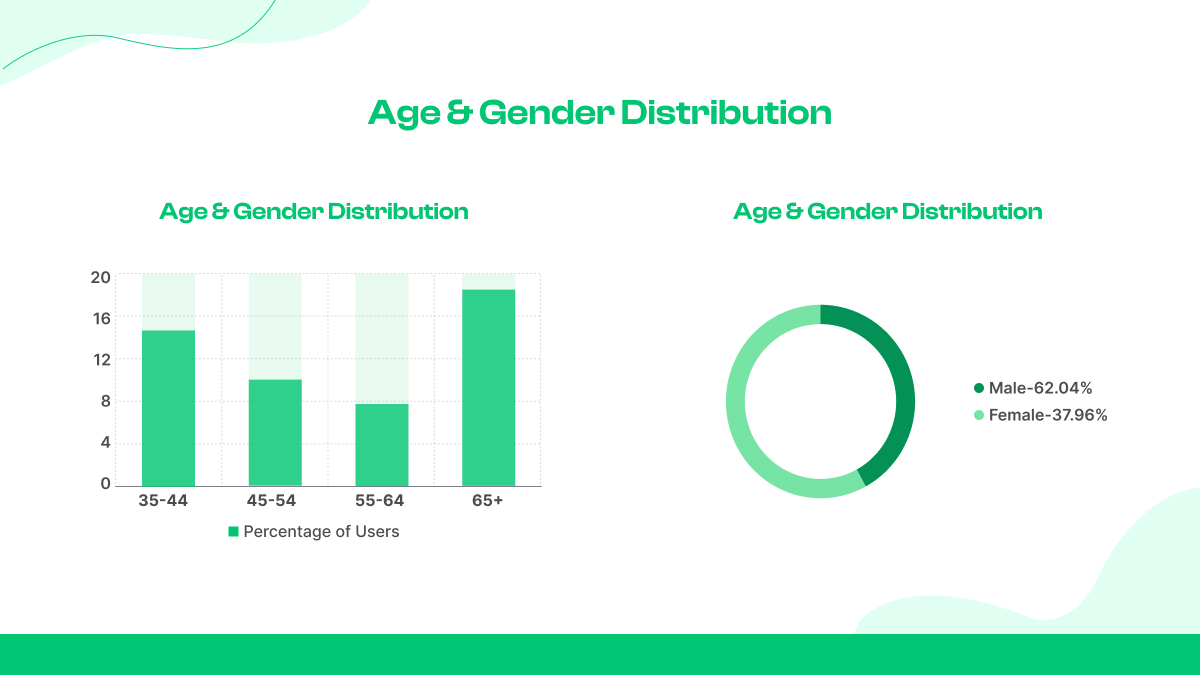
Bluesky users are predominantly young people under 35, with men being the most represented gender demographic.
Percentage of users by age brackets
It means roughly 62.69% of the platform’s user base is young people under 35.
The older age brackets are relatively smaller in Bluesky’s user base.
Gender split
Male users dominate the platform. Let’s see the numbers:
Some sources cite even higher male shares, almost up to 66-69%, based on the sampling method.
Based on the data, it can be determined that Bluesky’s user base is very young, mostly Gen Z and younger Millennials, and male-skewed.
Geographic Distribution
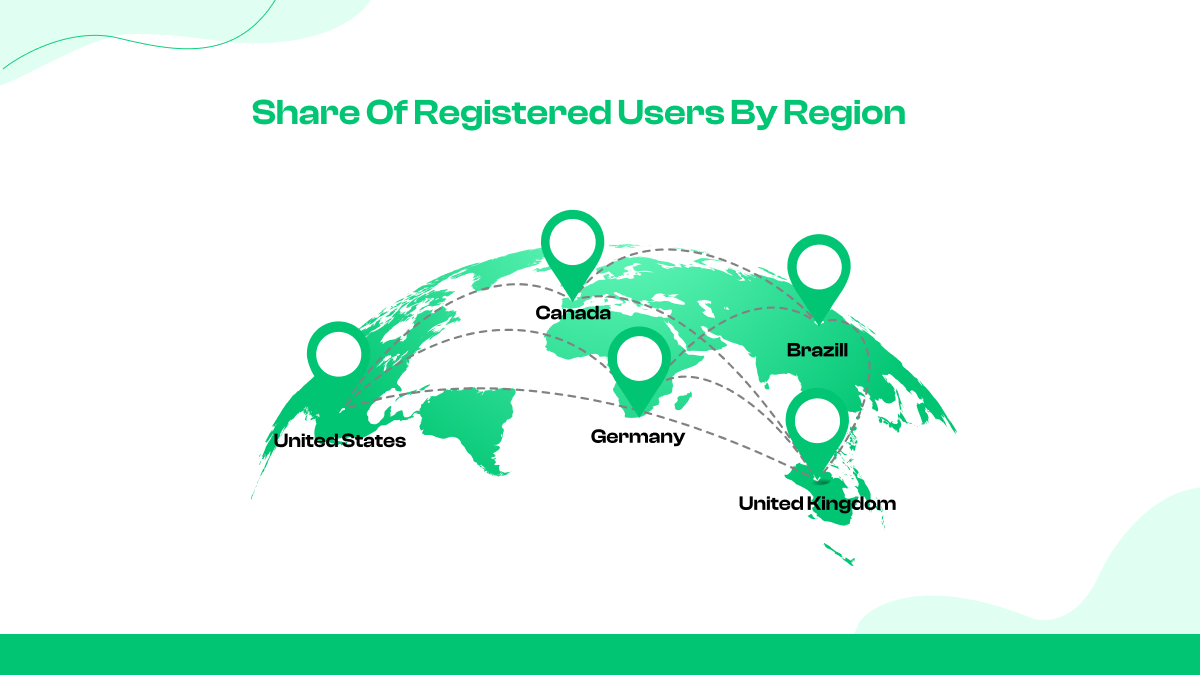
Bluesky has users across many regions of the globe.
Top countries by user base share
According to a sample of traffic data, the US accounts for about 42.27% of users, or visitors, in certain datasets.
In some reports, Brazil shows housing a significant number of users. For example, in a particular dataset, around 37.7% of all Bluesky’s traffic is from Brazil.
Other significant countries include Japan, with around 8-9% of users, and the UK, with 3-7% of Bluesky users.
Urban vs rural usage
A proper breakdown can’t be made due to the unavailability of data.
Language/region trends
English-speaking regions, like the US and UK, remain large contributors of Bluesky users.
Meanwhile, the number of Japanese users is also growing. According to a study, a significant contribution from English and Japanese users was noted during the early growth of the platform.
At the same time, the surge in users in Brazil suggests that content in Portuguese is also increasingly relevant for the platform.
Such geographic distribution points to a global expansion of the platform.
User Intent & Content Type Preferences
Let’s see if Bluesky has more active posters or more “lurkers” on the platform.
As per another dataset, 48% of users create posts of their own.
Device usage (mobile vs web)
On the website domain, around 58.36% users visit Bluesky from desktop computers. The remaining 41.64% log in from mobile devices.
While this indicates strong desktop usage for the web client, data specific to the mobile app versus web-app usage is less publicly detailed.
Most popular content formats (text, image, video)
Precise numbers are scarce in this regard. However, different analyses suggest that Bluesky favors text-based posts, thoughtful commentary, niche threads, and light meme/image combinations, instead of formats that feature heavy videos.
As the platform keeps growing, video features are getting more popular. However, it’s still less significant compared to larger social networks.
Time-of-day / day-of-week activity peaks
Specific time-slot statistics are not particularly accessible in datasets as of now.
Overall, Bluesky is a platform where listening and thoughtful engagement have more prominence. So, for creators or community-builders, it’s important to focus on quality, niche content rather than chasing virality.
Platform Market & Competitive Context
As a social media platform, Bluesky operates in a fast and evolving space of microblogging and decentralized social networks. While its scale is modest compared to X (formerly Twitter) or Threads, its growth trajectory, lean structure, and community-driven approach set it apart.
Comparison: Bluesky vs. Competing Platforms
Let’s have a look at the comparison between Bluesky and other similar platforms.
Registered Users: Bluesky vs. Threads vs. X vs. Mastodon
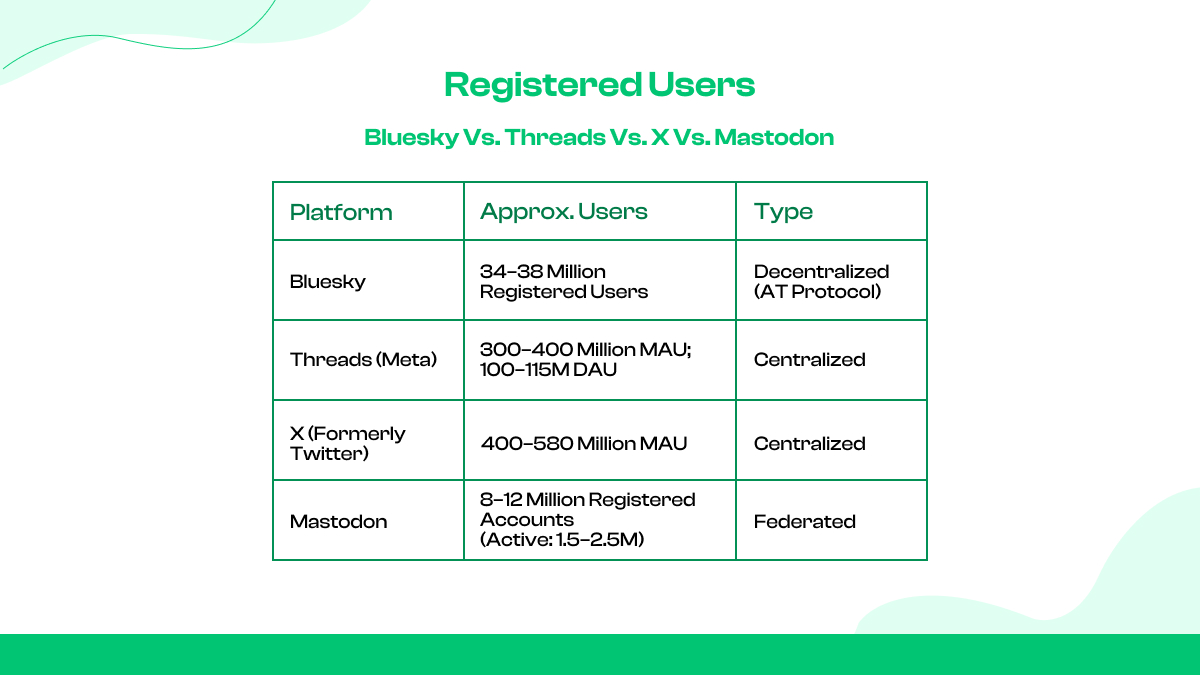
X and Threads are the dominating platforms when it comes to volume.
Meanwhile, Bluesky and Mastodon are prominent in the decentralized frontier. However, Bluesky’s user experience gives it an edge over Mastodon in terms of accessibility and retention.
Engagement Metrics: Session Time, Posting, and Community Activity
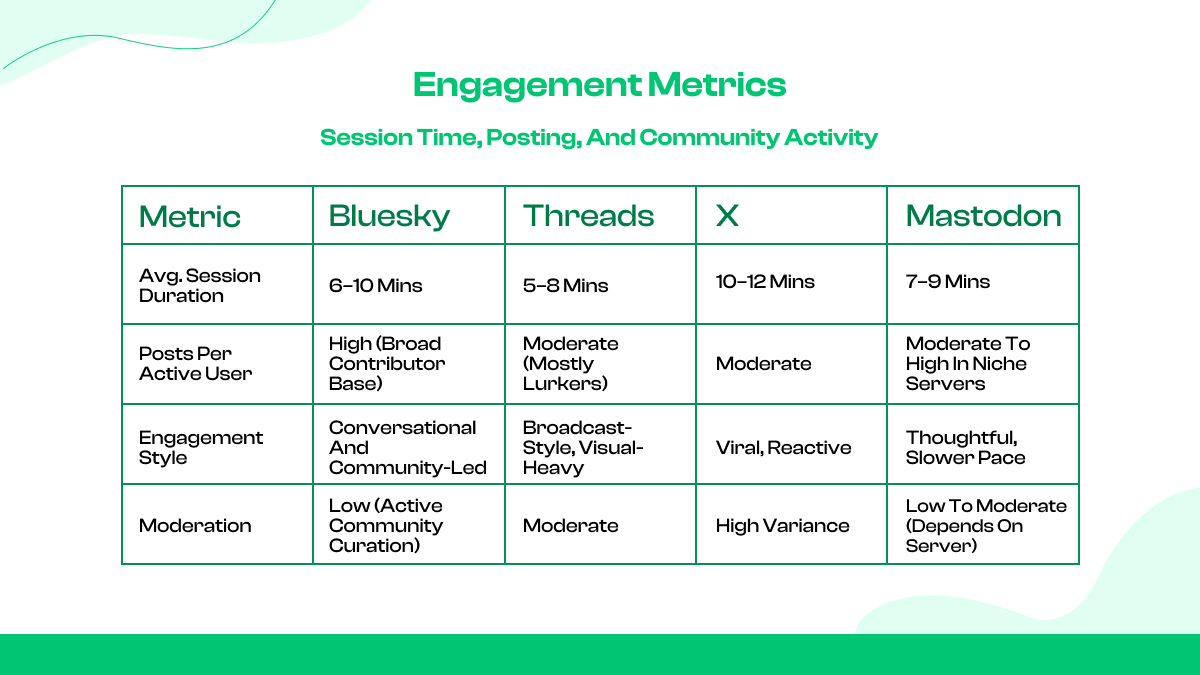
Which platform is growing fastest?
In early 2023, Threads gained 100 million users within days [Source: Forbes], recording the fastest growth. It continued to enjoy fast MAU growth through 2024 to 2025, largely driven by Meta’s global distribution and ecosystem. Recent data showed strong month-on-month gains as well.
X has been experiencing a comparatively flat or volatile growth, as user counts and engagement change based on product and policy changes. An established scale can make percentage growth seem lower even when absolute numbers are sizable.
Meanwhile, Bluesky has shown the highest percentage growth, gaining tens of millions of users in under two years. It indicates an impressive growth rate, and that too from a much smaller absolute base than Threads or X.
Business/funding & team size metrics
Let’s have a look at the business aspects of Bluesky.
Total funding raised (USD)
Bluesky’s public funding figures vary across different trackers.
Public trackers and databases list Bluesky’s total funding in ranges from low tens of millions ($15–36M cited by some aggregators) up to higher totals, depending on whether grants or secondary investments are counted.
One aggregator shows $36M across rounds, while another site lists more conservative numbers.
Number of employees/contractors
Bluesky runs with a small team of full-time staff. However, the platform supplements scale with contractors for moderation.
Full-time employees (public estimates): Around 20–30 full-time employees (company statements and LinkedIn range 11–50). As per reports from several sources in 2024-25, Bluesky operates with a small core team of 20 to 25, and plans to expand further.
Contractors/moderators: Reports suggest around 100 moderators working at Bluesky under contracts, while more are working as content moderators.
Revenue or monetization stats
Bluesky has publicly explored merch, premium features, and ecosystem monetization. However, transparent revenue figures are not widely published as of mid-2025.
Wired has reported early revenue streams like merchandise, alongside different experiments with subscriptions or partner monetization.
Platform Ecosystem & Network Structure
Through the network structure, such as how users follow each other, share content, and cluster into communities, you can gain a deeper understanding of how Bluesky works.
Follow Network Statistics
Let’s have a look at the following network stats first.
Total follow-/follower relationships across posts/users
A recent data set, titled “A Blue Start: A large-scale pairwise and higher-order social network dataset,” records 26.7 million Bluesky users and about 1.6 billion pairwise following relationships on the platform, as of the time of the study.
An earlier network topology study found that at one point, there were 2 million users in the followership network. Of them, around 600,0000 were in the likes network and 300,000 in reply/repost networks. It shows that the number of followers scales ahead of active engagement.
Average follows per user / average followers per user
As 1.6 billion follow relationships were recorded among just 26.7 million users, the average follows per user can be approximated at 60.
As the followers vs following relationships are symmetric relationships when it comes to total count,but skewed per user, some users have tens of thousands of followers while many have few.
In the “most-followed” data set, the official Bluesky account has 24–27 million followers.
Such a heavy-tailed nature refers to median follows/followers being much lower in number. Many users follow or are followed by only a few dozen accounts.
Most-followed accounts (top 10)
Here is a representative list of the most-followed Bluesky accounts (numbers as of early/mid 2025):
.jpg)
Content Sharing / Network Features
Now it’s time for an in-depth look at the content sharing or network features.
Usage of “Starter Packs” or curated lists
Bluesky supports user-curated “starter packs”, which means lists of recommended accounts to follow. These lists have been highly influential, with more than 335,000 starter packs created in the first six months of adoption, as found by researchers.
These starter packs accounted for up to 43% of all new follow relationships in peak periods and about 20% of all follow relationships in the measured study period of June 2024 to January 2025.
Users included in starter packs gained about 85% more followers and posted 60% more than similar users who were not in starter packs.
Mentions, quotes, reposts: structural network behavior
Bluesky’s reply, repost, and like layers are characterized by heavy-tailed distributions and high clustering. This means a small number of users generate a large number of interactions, while most users generate few.
For example, at its peak around May 2024, the weekly followership network had over 2 million users andthe reposting network had around 550,000 users, while the reply network had 300,000.
Network analysis: density, clustering, communities (high-level)
Bluesky’s network exhibits a high clustering coefficient and short path lengths, which are similar to larger social networks. That means users are fairly well connected on the platform, where communities also form quickly.
The “starter pack” mechanism introduces higher-order group interactions, as in users following packs of accounts. It fosters community formation beyond simple pairwise follows.
In the “A Blue Start” dataset, around 301,300 starter-pack groups were identified alongside the 1.6 billion follow relationships.
Despite the decentralized protocol, the user-behaviour network still resembles centralized networks, such as dominant influencer hubs, echo-chamber risk, and gradual community consolidation.
Implications for Content Creators & Communities
As follows are unevenly distributed, it can significantly improve visibility for a user if they get added to a starter pack. Creators and community managers should explore how to get their account included in popular packs.
The heavy-tail and clustering features mean that community participation, such as reposting, replying, and building conversation, tends to benefit growth more than passive follower counts.
The comparatively high connectivity suggests that network effects are active. Early adopters build more linkages and create clusters, which help accelerate their reach.
However, this structure also means competition for attention among influencers is real. However, smaller niche communities may offer better engagement for users, as one may have to battle with influencers for general reach.
Trends, Challenges & Future Forecasts
Bluesky’s story so far is one of rapid adoption, concentrated engagement, and growing pains. According to data, it’s a platform that can grow fast following catalytic events, but also faces retention and content-quality challenges that are common to fast-growing social apps.
Below ,we will summarise recent trends, some key statistical problems, and three scenarios for what the rest of the year could look like.
Recent trends: growth surges & slowdowns
Let’s first have a look at some key growth events.
Key growth events
Post-election & competitor shocks: Bluesky saw significant surges in users following high-visibility events on competitor platforms. For example, after the US presidential election in late 2024, the platform added roughly 1–1.25 million users in a single week. Meanwhile, earlier spikes also followed policy changes and regional restrictions on X.
Invite → public opening: The move from invite-only to open registration helped the platform enjoy a sustained adoption wave that helped it gain users rapidly through 2024 to early 2025.
Growth slowdowns & engagement softening
After peak periods of user sign-ups, engagement metrics, such as daily posters, likes per post, DAUs, etc., showed signs of flattening or decline in parts of 2025.
Multiple analyses and reporting in mid-2025 flagged declines in daily active posters and lower median engagements per post, in comparison to earlier months.
Regional booms and dips
Brazil and parts of Asiahaves repeatedly shown regional booms, which were tied to local events or content creators joining the platform. But regional interest can be bursty, as the platform usually sees a surge when local alternatives are disrupted or when creators move en masse.
Challenges revealed by the stats
There are several challenges as well that Bluesky is facing right now.
Ghost accounts / inactive user share
There is a significant gap between registered users and daily active users. The DAU/registered ratio is in the range of 10–15%, which indicates that many accounts are infrequent or inactive users.
Such “ghost accounts” are common for platforms that scale through viral sign-ups but struggle with long-term retention.
Moderation & content-quality metrics
Moderation and community quality also need to be addressed.
Internal moderation relies on a small core team, alongside contractors. So far, many public complaints and debates have been raised about the platform’s moderation policy.
Bluesky’s report volumes and formal moderation KPIs are not published. However, qualitative reporting suggests moderation load increases when growth surges. Until the platform publishes formal transparency reports, most figures are anecdotal or vendor-tracked.
Feature adoption (direct messages, video posts, etc.)
Bluesky does not publish full feature-usage breakdowns.
The platform predominantly has a text-firstandd conversational style. Third-party observation indicates text & reply threads dominate platform activity, while images and limited video content are gaining traction. It, however, is still less central than on larger and video-first platforms.
Estimated adoption: A large number of active users use DMs at least occasionally, which is on par with text-first social apps. However, the precise rates for DM, video posting, or story-style features are not publicly reported.
Overall, Bluesky’s long-term success depends on turning casual sign-ups into repeat and meaningful usage. At the same time, they also need to scale content quality controls.
Forecasts & projections
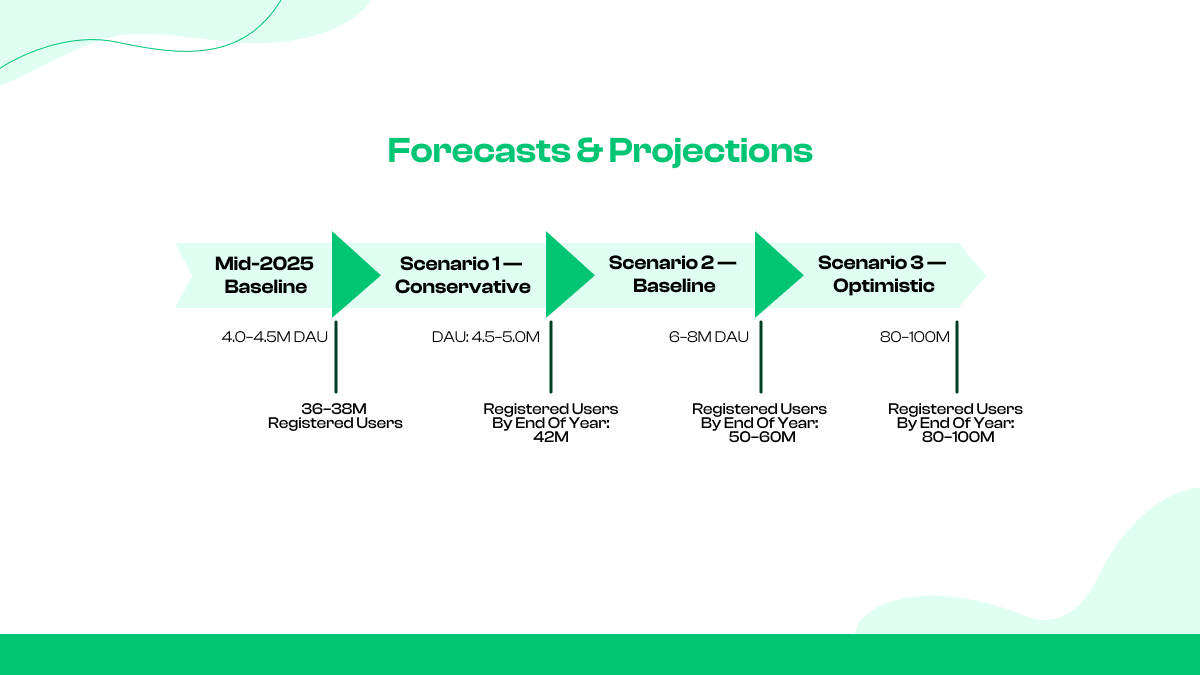
Below are three scenarios for Bluesky’s end-of-year registered users and DAUs-
These are scenario projections, and not promises, which combine recent growth rates, third-party trackers, and public forecasts.
Engagement/DAU forecasts (trend)
According to baseline assumptions, the DAU/registered users ratio could improve from 10–15% to 12–18%, with product improvements and onboarding may increase retention, at least marginally.
However, achieving parity with mainstream platforms will require sustained increases in both daily habit formation and content breadth.
Potential market share in micro-blogging/social spheres
By the end of this year, it may be possible for Bluesky to command a meaningful single-digit percentage of the global micro-blogging attention market.
However, it is unlikely to overtake massive competitors like X or Threads in absolute scale within the same period, unless any extraordinary events take place.
Grow Your Bluesky Presence with Socialplug!
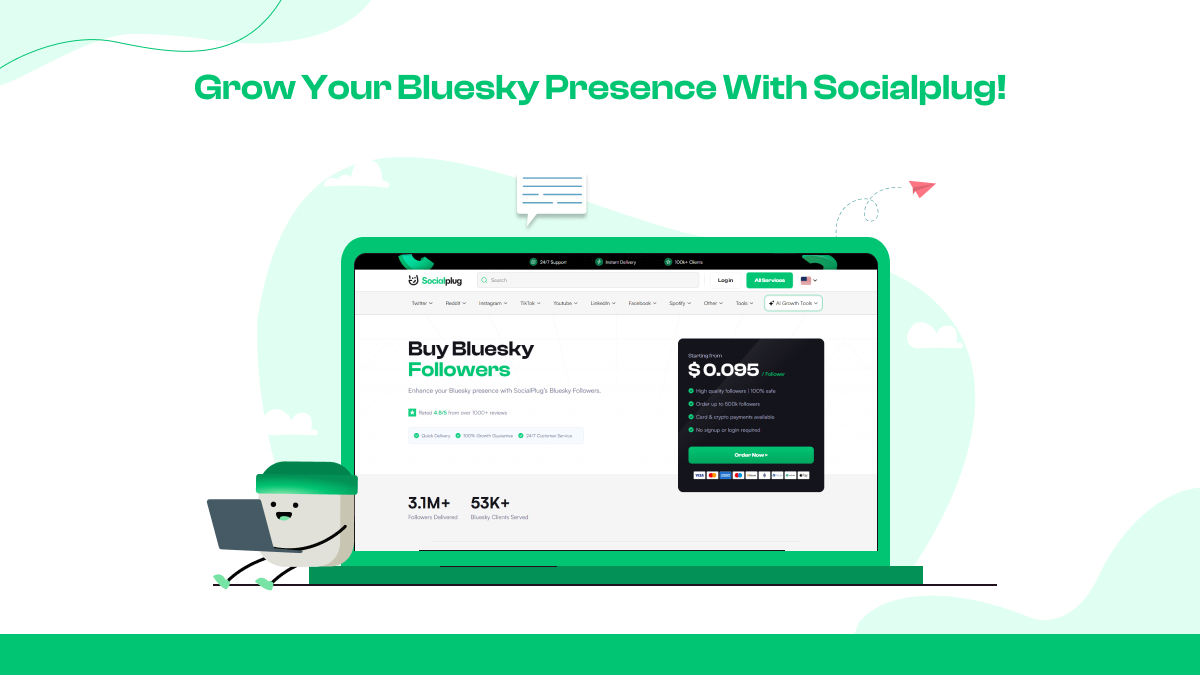
Bluesky’s rapid rise shows that decentralized social networking isn’t just a passing trend; rather, it’s reshaping how people are connecting online these days. The platform offers a unique opportunity for creators, brands, and communities to grow without the noise or manipulation seen on regular platforms.
But as with any platform, visibility takes effort. That’s where tools like Socialplug come in.
If you’ve been waiting for the right time to grow your presence on Bluesky, this is it.
Frequently Asked Questions
Where does Bluesky’s data come from?
Most Bluesky data comes from independent analytics platforms and verified media sources, like TechCrunch and Business Insider. Since Bluesky’s protocol is open, some third-party developers also aggregate anonymized data directly from public network activity.
Can developers access Bluesky’s metrics through an API?
Yes, partially. Developers can use the AT Protocol API and community-built tools to access certain public data points. However, Bluesky limits access to private or sensitive engagement data to preserve user privacy.
Does Bluesky publicly share its official statistics?
Not regularly. Bluesky occasionally discloses user milestones through its official blog or via CEO Jay Graber’s updates. But most granular metrics, such as daily activity or demographics, are derived from external analytics and developer tools.
Is Bluesky growing faster than Mastodon or Threads?
Yes. As of 2025, Bluesky’s growth rate outpaces both Mastodon and Threads in percentage terms. While Threads has a larger overall base (275M+ users), Bluesky’s growth of over 3,500% since early 2023 shows stronger momentum.







.svg)
.svg)





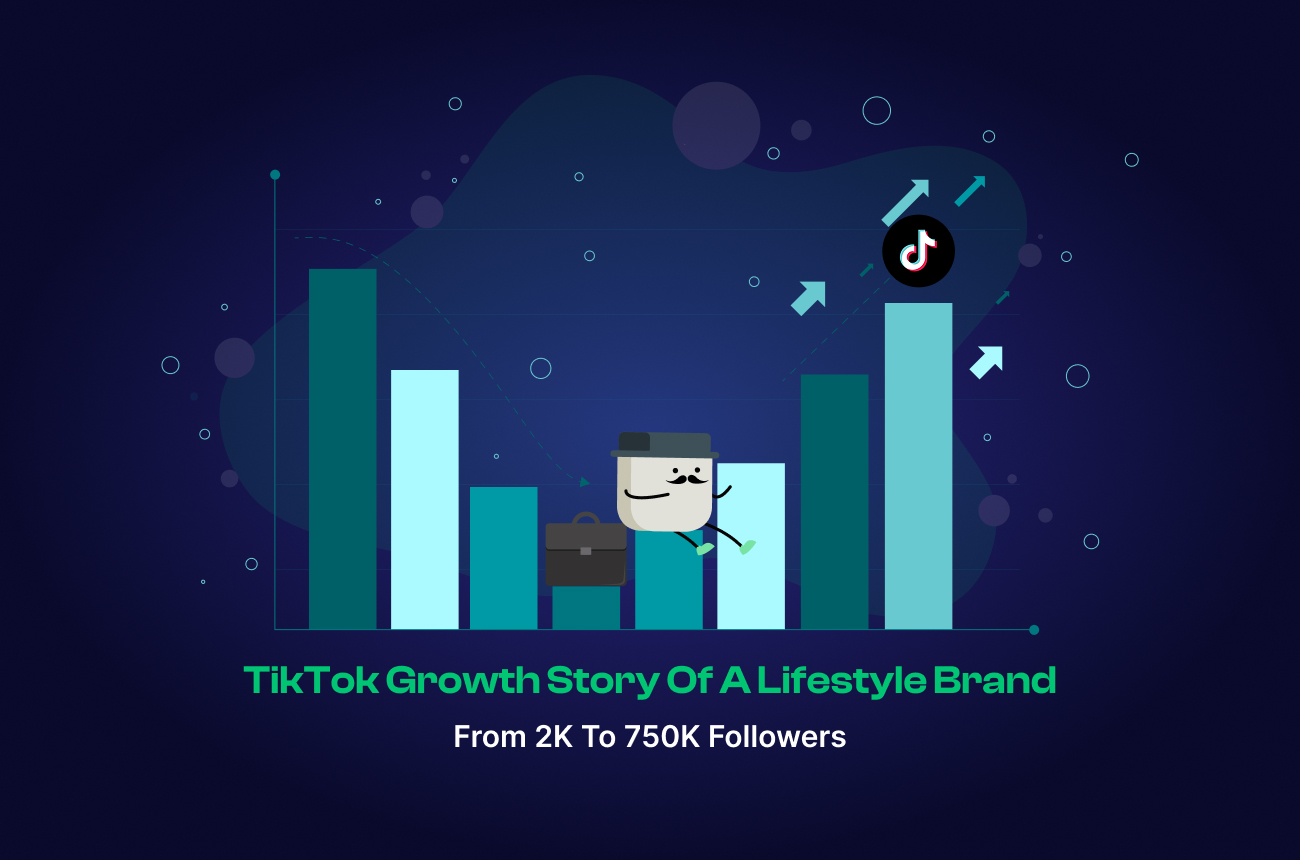


0 Comments
Great tips! I never realized how much engagement impacts growth more than just posting frequently. I've been focusing only on content, but now I see how interacting with my audience can make a difference. Time to step up my strategy!
Super helpful article! I always thought Facebook Groups were just for discussions and never really considered them as a tool for growing followers. The idea of actively engaging and sharing valuable content in relevant groups makes so much sense. I'll definitely start participating more and see how it impacts my page. Thanks for the great advice!